To watch the first Mars Exploration Rover (Spirit) landing realtime, I bought a ticket for "Wild About Mars", the big celebration put on by The Planetary Society in the Pasadena Convention Center. The landing was expected at 8:35 p.m. I got there around 6:30 p.m., with the place was already packed (I heard estimates that 2000 people attended). It was a fabulous evening, with lots of great speakers and lots of great news from the lander!
What I have chronicled here is my experience at the Wild About Mars party, and the excitement of seeing those images come in. For the best current pictures, see JPL's website.
The Planetary Society had a full-scale Mars Exploration Rover model, made completely out of legos. It was really impressive. The detail is great, down to the wheels, the high-gain antenna, the pancam on the mast, the solar panels, etc. (The second shot here is a close-up of a solar panel). The final picture is of a model of Phoenix, the Scout mission aiming to launch in 2007. It will be the next Mars lander mission.
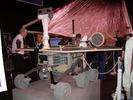 |
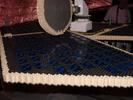 |
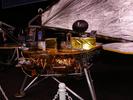 |
The Mars lectures then began with a brief address from Ray Bradbury. He does not seem to be in good physical health, but his words were as passionate and fiery as ever.
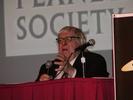 |
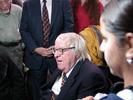 |
Describing the average Smithsonian lecture, he said: "It's full of people... snoring." |
Dr. William Hartmann was to give an introduction to the chosen landing site, Gusev Crater, but the schedule got a bit shifted around and that ended up happening much later in the evening. But his intro deserves to be here (see Gusev Crater on the right). I also have a shot of Donna Shirley, previously head of the Mars Exploration Program at JPL (during the Pathfinder mission).
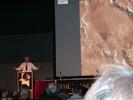 |
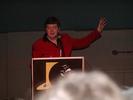 |
Donna describes the tension in mission control, because the rover is headed in for a landing on its own, and "There's not a darn thing they can do about it now." |
At about 8:30, the "six minutes of terror" began with the rover hurtling into the Mars atmosphere and its entry, descent, and landing (EDL) sequence.
Then some minutes of tension returned, as they guessed that the rover should have stopped bouncing and rolling, but no signal was coming through from it. Eventually... we heard the good news: the rover had made it! Jubilation at the Convention Center
Everyone at the Convention Center took a break for a while, with the promise that in a couple of hours we might see the first signals being relayed from the rover, through Mars Odyssey (orbiting Mars), and back to Earth. There were no promises about what we might see -- it might be as simple as some rover telemetry data indicating its health status, or we might get an image or two. What we eventually got, around 11:30 p.m., was phenomenal.
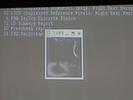 |
This was the very first image that showed up on the screen. It is a picture of the little sundial on the rover (which is also its calibration target). We were all excited, despite how tiny, dark, and blurry it was. |
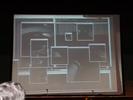 |
But then... more images started popping up. Within seconds, they filled the whole screen. People went wild. |
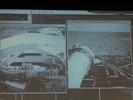 |
And then *big* images started appearing. The one on the left is a view from the hazcam (hazard detection camera), which is mounted low on the rover. I believe what you see at the top of the image is the reflective underside of the stowed solar panels. The image on the right shows the pancam (panoramic camera) mast in its stowed position, lying down. |
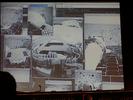 |
Finally, we ended up with a plethora of goodies -- all sorts of crisp, cool pictures to feast our eyes on. Suddenly, we were drowning in new images of Mars. The people in mission control were just as overwhelmed, exclaiming, "LOOK at that!" and "See the rocks?" and "Oh my god." and "That's something that no one's seen before." |
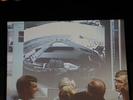 |
Close-up of the rover. |
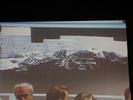 |
The rover raised the pancam mast and started taking navigational images.
"We have deployed the pancam
mast assembly." Within minutes, the team had pasted together a variety of these navigational images into a panorama of the landing site. Stunning. |
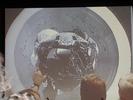 |
Then they showed us the landing site from above (a different projection of the same data). Note the excited pointing in mission control. |
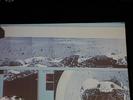 |
And here's the final, filled-in panorama. You can see small hills (or crater rims) on the horizon, though they're difficult to see in this version. Again, check out the JPL site for better versions of these pictures. You can also see some interesting shallow depressions in the distance. |
After all of the excitement, several NASA and JPL officials appeared for a press conference. Sean O'Keefe (head of NASA) poured them all champagne to celebrate.
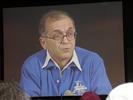 |
Dr. Charles Elachi, director of JPL:
"Things worked out." |
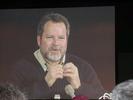 |
Robert Manning, Systems Engineering Integration and Test Manager, was one of the best speakers. He was riveting even when his excitement rendered him incoherent, as in this description of how great the mission team is: "People, people who are just... you know... people are..." |
Next, we were treated to a dramatic reading of part of Ray Bradbury's "Leviathan", where spaceship captain Ahab goes after the Great White Comet.
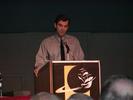 |
Dan Ganntt played the part of Ishmael. "Here with strange new ships, sail for the stars, instead of [under them]." |
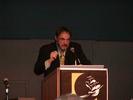 |
John Rhys-Davies was absolutely *stunning* as Ahab. He had the
audience utterly captivated. "How do you shoot for the meteor?!" "Ten seconds, captain!" |
We had another press conference, this time including Steve Squyres (from Cornell), who is the science PI for the mission. He was clearly ecstatic about the landing site and the success and the images that had come back.
The evening wrapped up (by now it was nearly 1 a.m.) with a great panel discussion that included Bruce Murray, David Brin, Greg Bear, and Bill Nye.
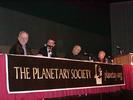 |
All four distinguished speakers. |
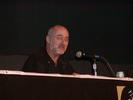 |
David Brin spoke for several minutes on the desire and need for exploration. He claimed that an early explorers would go "[to] stake out a vast territory for himself..." but that's harder with Mars being so far away, with no cities and princesses to win. Yet he insisted that we are drawn by the lure of the alien and that we must continue on. |
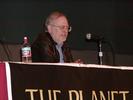 |
Greg Bear spoke on the possibility of finding life on Mars, and opined that, eventually, "So I think that we will find that answer." |
I finally headed home after 1 a.m., exhausted. It was a glorious evening, full of personalities, excitement, and accomplishments. I'm glad I could be there.